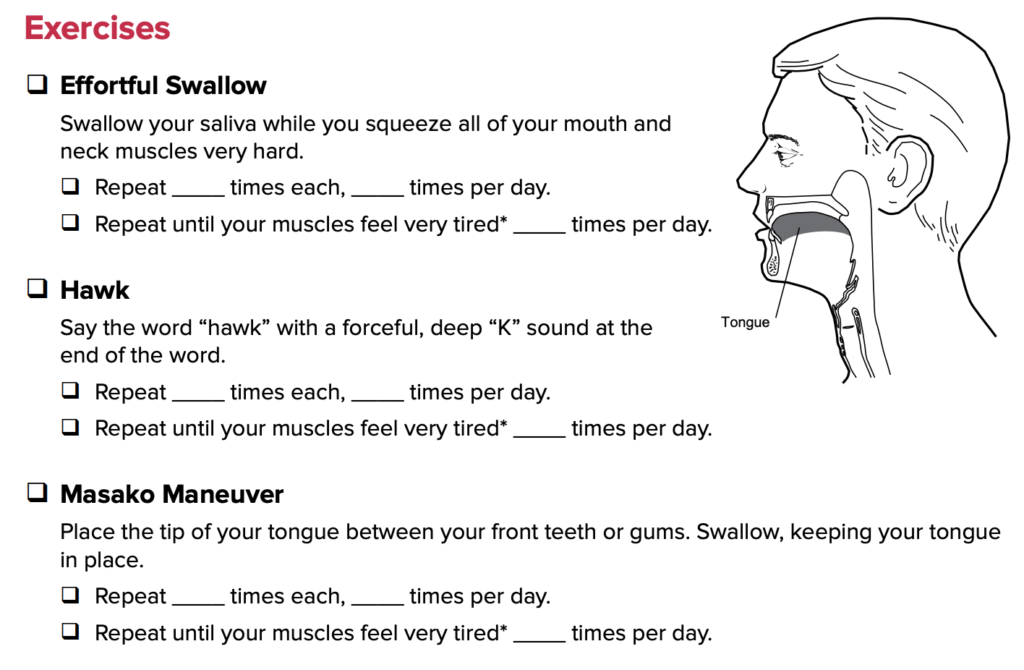01 May Dysphagia Speech Therapy

Dysphagia refers to any condition that involves the difficulty in chewing and/or swallowing food or liquids. Dysphagia is caused, in many cases, by conditions such as stroke, Parkinson’s Disease, and other neurological illnesses such ALS, MS, and Dementia. These conditions can weaken the muscles within the oral cavity, including the lips and tongue, causing chewing and manipulating food and liquid in preparation for swallowing difficult or unsafe.
- If chewing muscles are weak, food may not be thoroughly chewed enough to safely swallow.
- If tongue muscles are weak, food or liquid may escape over the back of the tongue and into the throat before swallowing is initiated causing a choking hazard.
- If laryngeal muscles, the muscles involved in swallowing, are weak or impaired, food and/or liquid may escape into the airway, and then from there into the lungs. This is called aspiration. Aspiration of food or liquid into the lungs can cause what is known as Aspiration Pneumonia, which can be very dangerous and possibly deadly.
Download the Ohio State University Pamphlet on Dysphagia to learn more.
Dysphagia Speech Therapy
The Role of a Speech Language Pathologist
When treating Dysphagia with therapy, the role of the Speech Language Pathologist is to evaluate swallowing dysfunction and difficulties using tools such as a Bedside Dysphagia Evaluation, Modified Barium Swallow Evaluation (MBS), or Fiberoptic Endoscopic Evaluation (FEES).
The Bedside Dysphagia Evaluation involves the visual assessment of the muscles used when swallowing and the presentation of a variety of food and liquid consistencies to determine the safest diet for the patient.
The Modified Barium Swallow Evaluation is performed by a radiologist and Speech Language Pathologist. During the evaluation, the patient is placed in front of a video X-ray machine and given a variety of food and liquid consistencies coated with barium to determine their risk for aspiration. This test is an important tool due to the ability to visually assess the patient’s chewing and swallowing muscles. If a patient is at risk for aspiration of foods or liquids, it is easily seen on the X-ray. After the evaluation, the Speech Language Pathologist may recommend changes in diet or a thicker consistency of liquids depending on what is safest for the patient.
The FEES is performed by a medical doctor or Speech Language Pathologist. This procedure is performed by inserting a fiberoptic tube through the nasal passage into the throat in order to assess the function of the areas around the voice box and upper esophagus during the swallowing process. The patient is given a variety of food and liquid consistencies to determine the safety of the swallow.
Dysphagia & Swallowing Speech Therapy Techniques
Once an evaluation has been completed the role of the Speech Language Pathologist is to determine not only the safest diet for the patient in order to reduce their risk of aspiration, but to determine the most effective treatment methods. In the case of a stroke, the goal of treatment may be to increase the strength of the chewing and swallowing muscles.
Swallowing exercises, such as the ones found below, are effective for those who have a known weakness with chewing and swallowing muscles!
These exercises are accomplished through the training of facial, oral, and pharyngeal using techniques such as VitalStim® Therapy or Thermal Stimulation Therapy. The patient may also be trained using swallowing strategies such as tucking their chin, alternating solids and liquids during meals, or performing multiple swallows to compensate for the decreased muscle strength.
VitalStim® Therapy is performed by a trained speech therapist utilizing an FDA approved electrical stimulation device applied to the muscles of the face and/or neck to stimulate muscle and nerve retraction to improve swallowing function.
Thermal Stimulation Therapy uses a cold swab or metal instrument to stimulate the facial arches at the back of the throat to increase the swallowing response. In the case of other chronic, progressive diseases such as Parkinson’s, the treatment may include oral and pharyngeal exercises, as well as changes in diet to accommodate decreased muscle strength. Diet changes such as consuming ground meats rather than whole, softer foods, and possibly the introduction of thicker liquids may be necessary to increase swallowing safety.
If a patient has been diagnosed with a severe risk for aspiration it may be necessary to recommend that an alternate method of feeding be instituted. This may be a temporary means of providing nutrition such as a nasogastric tube or a more permanent feeding tube, inserted directly into the stomach. The goal is always to provide the safest means of maintaining nutrition and hydration.
To learn more about the Dysphagia Speech Therapy at Trio Rehab, give us a call.


